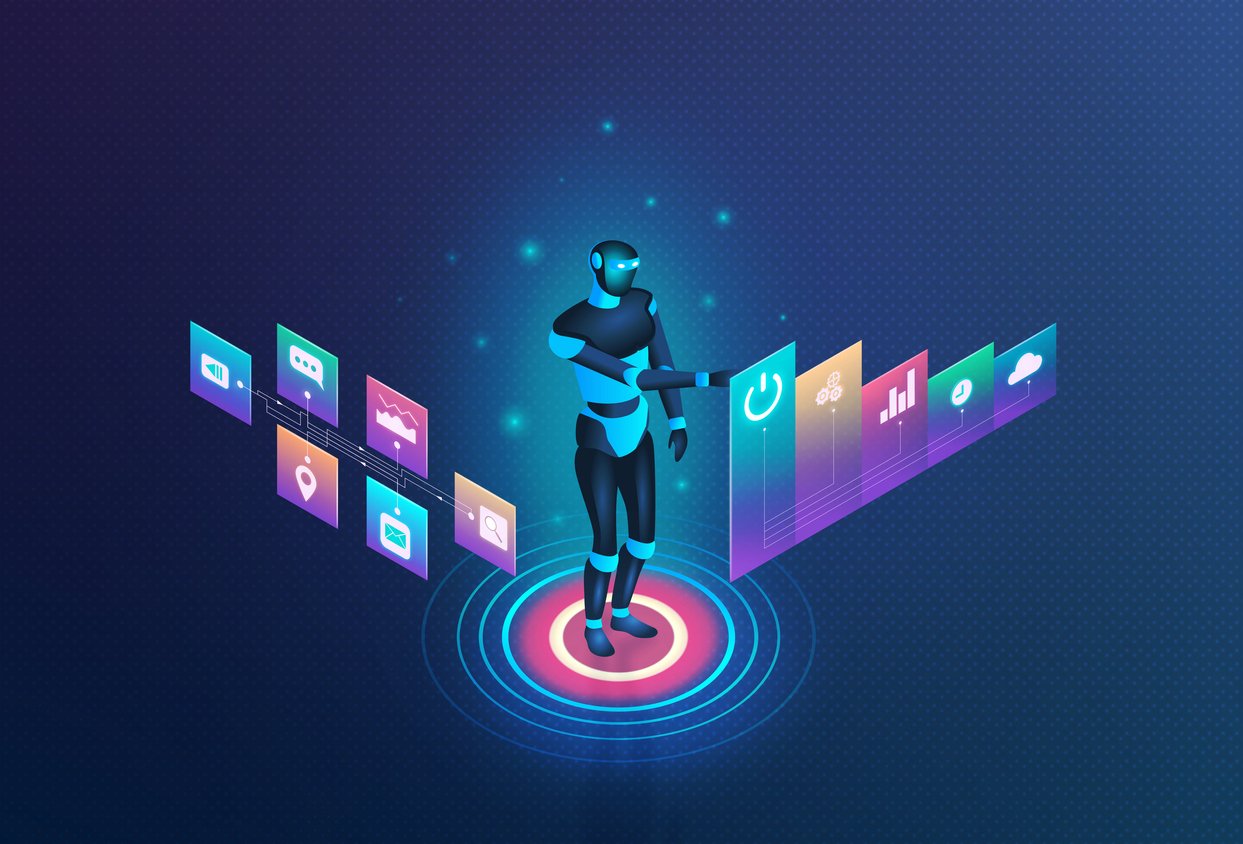March 12, 2024
 by Parvathy Nair / March 12, 2024
by Parvathy Nair / March 12, 2024

Remember the days of manually entering data into spreadsheets, cross-referencing paper files, and hoping for the best?
Thankfully, those days are fading thanks to innovative technologies like robotic process automation (RPA) and hyperautomation.
Driven by these technologies, enterprise workflows have transformed dramatically, leaving behind the era of manual exertion and data silos. RPA introduced efficient task automation, streamlining repetitive work and minimizing errors.
Following this, hyperautomation took things a step further by unifying RPA with other technologies like AI and machine learning (ML) to not only do tasks but also redesign entire workflows, unlocking strategic insights and empowering human-machine collaboration.
Delving deeper, we'll define and explore RPA and hyperautomation and how they empower businesses to achieve new levels of productivity.
With the constant addition of new automation software options in the market, it's understandable to get lost in the terminologies. Let’s simplify things by unpacking RPA and hyperautomation.
RPA technology automates repetitive, rule-based tasks through software robots or bots. Interestingly, the tech doesn’t involve walking robots or droids despite the misleading name.
These bots mimic human interactions with digital systems, performing tasks useful for organizations, such as data entry, invoice processing, and report generation with precision and speed. RPA aims to automate specific tasks within existing processes, often focusing on routine, manual activities that consume significant time and resources.
For example, automating repetitive tasks such as new hire data entry, payroll processing, and leave management through RPA can free up HR personnel to focus on strategic initiatives.
Hyperautomation, in contrast to RPA, represents a wider approach to automation.
It integrates various technologies, including RPA, along with AI, ML, and natural language processing (NLP). Unlike traditional RPA, which targets isolated tasks, hyperautomation aims to automate workflows, including complex decision-making processes and interactions across multiple systems and departments.
Consider an insurance company using hyperautomation to handle the entire claims process. RPA bots can gather information from various systems, AI can analyze images and data to assess the damage, and NLP can be used to communicate with the customer and adjust the claim amount.
This entire process, traditionally requiring multiple employees and departments, can be streamlined and automated through hyperautomation.

Source: Autonom8
Although both forms of tech entail some degrees of automation, there are some levels of differentiation. Hyperautomation and RPA differ in their scope of application, tech efficiency, and use cases.
Hyperautomation is a comprehensive approach that leverages technologies such as RPA bots, AI, and ML to optimize and automate processes from beginning to end. It involves more than simply performing repetitive tasks; it involves reimagining the way work is done.
Hyperautomation enables intelligent decision-making, learning, and ongoing improvement in accuracy.
This differs from RPA, which focuses on automating specific manual steps within a process. RPA focuses on automating individual, repetitive tasks within existing processes, like data entry and basic calculations. This focus on shallow automation with pre-defined rules makes implementing it faster but less adaptable.
We could liken hyperautomation to a toolbox equipped with a range of tools. RPA bots act as specialized screwdrivers, while hyperautomation offers an entire toolkit, including wrenches, pliers, and more, to tackle diverse automation needs across an organization's workflows.
To better understand the differences, let’s consider a common use case from the banking sector: mortgage processing.
RPA can be used when processing a mortgage to automate tasks such as verifying income documents, performing know your customer (KYC) checks, extracting data from tax forms, and calculating loan eligibility. This enhances efficiency and accuracy within the mortgage application process by eliminating manual effort and reducing errors.
However, if the same bank expands its services to include fraud detection, hyperautomation would become essential. Detecting fraudulent transactions requires a more comprehensive approach beyond the simple task automation that RPA can provide.
Hyperautomation would thus combine RPA bots for data collection with its allied advanced technologies like ML and NLP to analyze transaction patterns, identify anomalies, and flag potential fraudulent activities. By integrating multiple technologies, hyperautomation enables the bank to detect and prevent fraud more effectively while minimizing false positives and improving overall security.
When deciding on the most suitable tool, organizations must carefully evaluate their unique automation requirements and goals, considering the complexity and extent of automation needed.
While RPA has been instrumental in improving operational efficiency, the limitations of task-level automation have prompted organizations to seek more comprehensive solutions. To answer this demand, hyperautomation emerged.
So, what are the challenges RPA couldn’t smooth over that led to the evolution and subsequent adoption of hyperautomation?
RPA, as we’ve gathered so far, is restricted to predefined and repetitive tasks, hindering scalability and adaptability. While efficient, it’s similar to having individual machines working independently on parts.
In contrast, hyperautomation connects them into a seamless, efficient production line, churning completed products. RPA bots can be seen as individual workstations, while hyperautomation acts as the control system optimizing the entire flow.
Although RPA bots have undoubtedly enhanced operational efficiency by automating isolated tasks, such individual efforts often resulted in a singular approach, lacking holistic insights.
With this in mind, the issues that hyperautomation sought to overcome were:
RPA often focused on automating individual tasks, leaving businesses with a fragmented view of their processes. This black box approach made identifying optimization opportunities and measuring overall impact difficult.
Automating single tasks within a process could create islands of automation surrounded by manual steps or disconnected processes. This disconnect can hinder end-to-end efficiency in several ways, such as creating bottlenecks where manual intervention is still required to bridge the gaps between automated tasks.
Manually transferring information between different systems or departments can result in delays, errors, and inefficiencies.
Time has accelerated the demand for an always-on, digital society, making hyperautomation crucial to adapt. While RPA may automate independent tasks, it lacks the agility to adapt to changing processes or integrate seamlessly with other systems. The march towards this more digital society has reshaped how businesses operate and interact with their customers.
This transformation has been propelled by rapid technological advancements, shifting consumer preferences, and the growing importance of data-driven decision making. In short, traditional methods of conducting business no longer seem to be sufficient to meet the demands of today's fast-paced world.
Hyperautomation, thus, moves past the RPA scalability limitations and offers a broader approach, integrating various technologies to automate workflows and drive processes forward.
Hyperautomation doesn't just optimize individual workflows — it transforms how entire organizations operate. So, what are the areas experiencing improvement by implementing hyperautomation?
In many businesses, decision-making processes have been hindered by silos, where information is kept separate in different departments. This has led to inefficiencies and delays in decision making.
However, hyperautomation can help by allowing data to flow seamlessly across departments and systems. This gives decision makers a comprehensive view of operations in real time.
Additionally, hyperautomation uses advanced analytics techniques such as predictive modeling and machine learning to forecast future trends and outcomes.
Hyperautomation also enables organizations to implement adaptive decision-making processes. Organizations can quickly respond to evolving business needs and market dynamics by dynamically adjusting decision making algorithms and workflows based on changing conditions or objectives.
This approach emphasizes cross-functional collaboration.
Hyperautomation uses AI, ML, and NLP technologies together, which is crucial in driving intelligent and adaptive automation.
Let's delve deeper into how each technology contributes to this transformative approach.
AI-powered algorithms enable automation systems to learn from data, adapt to changing conditions, and make informed decisions autonomously. This results in automation processes that are not only efficient but also capable of handling complex tasks and decision making.
Hyperautomation also incorporates ML algorithms.
These algorithms analyze data to identify patterns, trends, and anomalies, allowing automation systems to optimize processes over time. By learning from experience, ML-powered automation becomes increasingly effective and accurate, driving continuous innovation and efficiency gains.
Hyperautomation also goes beyond AI and ML and incorporates other advanced technologies, such as NLP and cognitive tools. NLP enables automation systems to understand and process human language, facilitating communication and interaction with users and systems.
Cognitive tools augment automation processes by simulating human-like cognitive abilities such as reasoning and problem-solving.
Hyperautomation creates a multifaceted approach, allowing diverse technological tools to work in unison, which organizations can use to maximize efficiency and innovation.
While hyperautomation presents numerous advantages, it's also prudent to acknowledge potential challenges when deciding what tools your business would benefit from.
Implementing and managing hyperautomation requires diverse skill sets, including AI expertise, data governance specialists, and change management professionals.
Attracting and retaining this talent can be demanding for some organizations that are only beginning to expand their operations.
Integrating various technologies seamlessly can be complex, requiring careful planning, testing, and potential data migration considerations.
Using multiple advanced technologies in hyperautomation platforms requires a deep understanding of the advancements, how they work, and how they can be integrated with the existing system. This makes hyperautomation complex and involves more time to implement.
Hyperautomation necessitates robust data governance strategies to ensure data security, compliance, and ethical use. This requires clear policies, access controls, and ongoing monitoring.
Establishing clear data governance policies and access controls would be essential to govern the data lifecycle within a hyperautomated environment. Organizations might have problems when they attempt to scale their automation and add new identities (referring to human and nonperson identities like databases and cloud services) into their environments without a system to track and monitor them.
To maximize effectiveness, organization teams should establish a clear separation of duties, ensuring that individuals do not have conflicting responsibilities that could pose risks.
As we can see, both RPA and hyperautomation offer businesses the potential to streamline operations, enhance efficiency, and unlock new productivity levels. But what does the future hold for them?
Let's look at the individual trajectories of these technologies and explore how they will continue to reshape the way we work.
While hyperautomation is gaining traction, RPA's journey is far from over. The following are two key trends shaping RPA's future.
Curious which tools are leading the charge in RPA? Explore the best robotic process automation software for 2025 to streamline your workflows.
Looking ahead, we can expect accessibility to RPA technology to improve significantly, paving the way for more widespread adoption across industries and organizations of all sizes.
As RPA becomes more accessible, we can anticipate the emergence of a new wave of citizen developers – individuals within organizations who possess domain expertise and a deep understanding of business processes but lack formal coding or technical backgrounds. These individuals are empowered to create, deploy, and manage automation solutions using low-code or no-code platforms.
This coming of citizen developers is sure to build a culture of innovation and collaboration within organizations.
RPA is poised to integrate more deeply with advanced technologies like AI, ML, and NLP. This integration will enable RPA bots to become smarter and more capable of handling complex tasks that require cognitive abilities.
The next phase of RPA's evolution may well be characterized by intelligent automation, where RPA bots not only automate repetitive tasks but also exhibit the ability to learn, adapt, and make decisions autonomously.
This would greatly benefit industries such as healthcare, finance, or manufacturing. Consider, for example, healthcare organizations automating tasks such as appointment scheduling, patient data entry, and claims processing. This would reduce administrative burdens and considerably free up healthcare professionals, allowing them to focus on delivering quality patient care.
Similarly, RPA systems can optimize production processes, supply chain management, and quality control, leading to increased efficiency, reduced costs, and enhanced product quality.
Hyperautomation isn't slowing down, either. The trends we can expect to see are:
We can anticipate deeper integration of hyperautomation with emerging technologies such as blockchain, augmented reality (AR), and virtual reality (VR). These technologies will complement hyperautomation by enhancing security, enhancing user experiences, and enabling new ways of interacting with automated systems.
By leveraging the capabilities of these emerging technologies, hyperautomation will further expand its scope and impact across industries.
With the building of more hyperautomated workflows, organizations will witness the emergence of a collaborative human-machine workforce.
Humans increasingly focus on tasks requiring creativity, critical thinking, and emotional intelligence, while machines handle repetitive and data-intensive activities. This collaborative approach to work will lead to greater efficiency, innovation, and job satisfaction as humans and machines use their respective strengths to achieve common goals.
For instance, hyperautomation could streamline data collection and analysis processes in a marketing department, freeing marketers from the tedious task of compiling reports and empowering them to interpret data insights creatively.
With automation handling repetitive data processing, marketers can dedicate their time and energy to devising innovative marketing strategies, crafting compelling narratives, and fostering deeper connections with customers.
Platforms for hyperautomation are expected to become more user-friendly, enhancing accessibility for a wider audience. This enhanced user experience can contribute to the democratization of automation, benefiting organizations of all sizes.
By enhancing accessibility, hyperautomation platforms empower users across various departments and roles within an organization to actively participate in the automation journey.
Business users, who may not have extensive technical backgrounds, can now use intuitive drag-and-drop interfaces, pre-built templates, and guided workflows to create and deploy automation solutions tailored to their specific needs and objectives. This democratization of automation will allow organizations to tap into their workforce's collective intelligence and creativity, driving innovation and agility from within.
With user-friendly tools and resources at their disposal, businesses can rapidly prototype, test, and iterate on automation solutions. Companies can stay ahead of the competition and drive continuous improvement in their operations - a much-needed increased democratization of automation.
As industries undergo rapid digitization, relying on aging manual workflows is no longer an option. RPA and hyperautomation present a path forward: RPA through incremental task automation and hyperautomation via wholesale transformation.
It’s easy to tell that both tools are beneficial when improving organizational efficiency. However, upon closer examination of company job functions, roles, and departmental requirements, it becomes evident that hyperautomation holds a distinct advantage regarding adaptability and scalability.
It emerges as the preferred solution for driving continuous improvement, innovation, and competitive advantage in today's dynamic landscape.
Ultimately, the choice between RPA and hyperautomation depends on each organization's specific needs and goals. Businesses that leverage both will gain the agility and cutting-edge capabilities to stay ahead of the curve in the evolving market.
Learn more about intelligent automation software and the top 10 intelligent automation tools according to G2 data.
Edited by Shanti S Nair
Parvathy is a content writer for Autonom8 Inc., which creates enterprise workflow management software. She enjoys simplifying tech speak for various stakeholders and learning how things work.
Improving efficiency and productivity helps keep up with customer demand, deliver a great...
 by Angela Ash
by Angela Ash
Workflow automation accelerates business communication and processes.
 by Abhinav Girdhar
by Abhinav Girdhar
Technology has redefined business efficiency. Companies like Uber, GrubHub, and Amazon operate...
 by Rukmani S.
by Rukmani S.
Improving efficiency and productivity helps keep up with customer demand, deliver a great...
 by Angela Ash
by Angela Ash
Workflow automation accelerates business communication and processes.
 by Abhinav Girdhar
by Abhinav Girdhar


